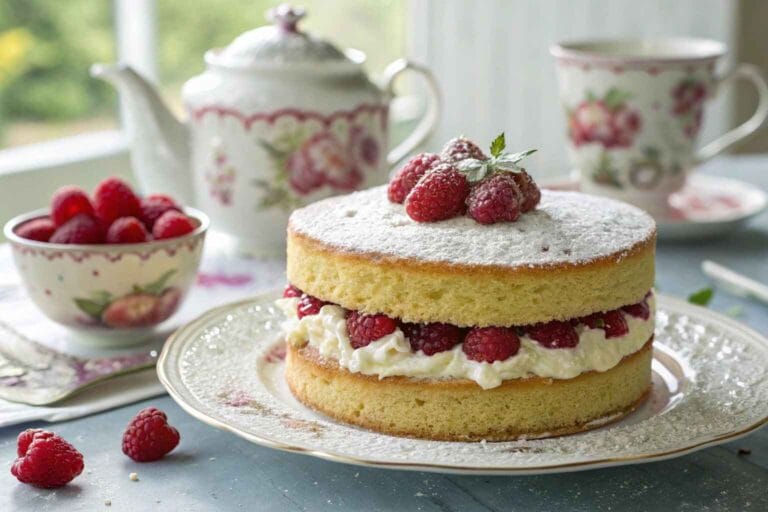Victoria cakes have captured the hearts of dessert lovers for centuries. Dive into their history, learn how to make them, and uncover tips to create the perfect slice every time.
Table of contents
What Are Victoria Cakes?
Victoria cakes are more than just a dessert; they’re a slice of culinary history. This quintessential British treat, also known as a Victoria sponge, features layers of light, airy sponge cake sandwiched with luscious cream and jam. But why has it stood the test of time? The secret lies in its simplicity and elegance.
If you’re wondering why this cake is such a hit at afternoon teas or family celebrations, it’s because of its perfect balance of textures and flavors. The sponge is buttery and soft, while the filling provides a sweet and tangy contrast.
The Origins of Victoria Cakes
The story of Victoria cakes begins in the 19th century, during Queen Victoria’s reign. This cake wasn’t just food—it was an emblem of sophistication. Queen Victoria herself was said to enjoy slices of sponge cake with her afternoon tea. Hence, the name “Victoria cake” became synonymous with high tea tradition.
But where did this recipe come from? Initially, sponges were denser and less refined. The introduction of baking powder revolutionized the texture, giving us the light and fluffy sponge we know today.
“A cake fit for a queen, quite literally!”
Ingredients
Creating a flawless Victoria cake starts with the right ingredients. It’s like assembling the pieces of a puzzle—each one plays a crucial role in the outcome. Here’s what you’ll need:
Table: Core Ingredients and Quantities
| Ingredient | Quantity |
|---|---|
| Self-raising flour | 200g |
| Caster sugar | 200g |
| Unsalted butter | 200g (softened) |
| Eggs | 4 large |
| Vanilla extract | 1 tsp |
| Raspberry jam | 150g |
| Double cream | 200ml (whipped) |
| Icing sugar (optional) | For dusting |
Tip: Always use room-temperature butter and eggs for a smooth batter.
Step-by-Step Recipe for Victoria Cakes
Preparing the Batter
Ready to get baking? Start by preheating your oven to 180°C (350°F). Grease two 8-inch round cake tins and line them with parchment paper.
- Creaming the Butter and Sugar:
Beat the softened butter and caster sugar together until pale and fluffy. This step is crucial—it’s what traps air in the batter, giving your cake its lift. - Adding the Eggs:
Gradually add the eggs, one at a time, while continuing to beat. If the mixture starts to curdle, a spoonful of flour will save the day. - Folding in the Flour:
Sift in the self-raising flour and gently fold it into the batter. Be careful not to overmix; we want a light texture.
Achieving the Perfect Bake
Divide the batter evenly between your prepared tins. Bake in the oven for 20-25 minutes, or until a toothpick inserted in the center comes out clean. The cakes should be golden, with a slight spring to the touch.
Variations of Victoria Cakes
What makes Victoria cakes so special is their versatility. You can tweak the recipe to suit your dietary needs or preferences.
Gluten-Free Victoria Cakes
If you’re looking to make a gluten-free version of Victoria cakes, it’s easier than you might think. To start, replace the self-raising flour with a high-quality gluten-free alternative. Additionally, for the best results, consider adding a pinch of xanthan gum. This small adjustment helps mimic the elasticity that gluten provides, ensuring your sponge stays light, cohesive, and delicious. By doing this, you can enjoy all the fluffiness and charm of the classic recipe without compromising on texture or taste!
Vegan Alternatives for Victoria Cakes
If you want to make a vegan version of Victoria cakes, it’s simple! First, swap the butter for a plant-based spread to keep it dairy-free. Then, replace the eggs with flaxseed mixed with water or aquafaba (the liquid from canned chickpeas). On top of that, vegan cream and jam fillings work perfectly, giving you the same delicious results without using animal products. With these easy changes, you can enjoy a cake that’s just as tasty and kind to the planet!
Modern Twists on the Classic Recipe
Feeling adventurous? Try adding lemon zest to the batter or using a chocolate ganache instead of cream. Some bakers even incorporate edible flowers for a stunning visual effect!
“Classic recipes are the foundation, but modern twists are where creativity shines.”
Common Problems with Victoria Cakes and How to Solve Them
No one likes cake mishaps, but they happen to the best of us. Here’s how to troubleshoot common issues:
Why Does My Victoria Cake Sink in the Middle?
This often happens when the oven temperature is too low or the cake batter is overmixed. To avoid this, preheat your oven properly and fold the batter gently.
How to Avoid Dry and Crumbly Cakes
Dry cakes can result from overbaking. Keep an eye on the timer and remove the cakes as soon as they’re done. Using quality butter also helps keep the sponge moist.
The Best Occasions for Victoria Cakes
Victoria cakes are incredibly versatile. Whether it’s a birthday, wedding, or a casual get-together, this cake fits the bill.
Celebrations and Special Events
With its elegant layers and customizable flavors, a Victoria cake can be dressed up for formal occasions. Add fresh berries or edible glitter to make it shine.
Afternoon Teas and Casual Gatherings
For a laid-back vibe, stick to the classic presentation. Serve it alongside a steaming pot of Earl Grey tea, and you’ll instantly elevate any tea party.
Storing and Preserving Victoria Cakes
Short-Term Storage Tips
If you’re planning to enjoy the cake within a day or two, store it in an airtight container at room temperature. The cream should remain fresh for at least 24 hours.
Can Victoria Cakes Be Frozen?
Yes! Wrap the sponge layers individually in plastic wrap and freeze them for up to 3 months. Defrost at room temperature and add the filling before serving.
Victoria Cakes Around the World
Victoria cakes may have originated in Britain, but their charm has spread across the globe. While they remain a classic in the UK, many countries have put their own spin on this timeless dessert.
Popularity in the UK and Beyond
In the United Kingdom, the Victoria sponge is often seen as a symbol of tradition. From quaint tea rooms to upscale bakeries, you’ll find this cake served with pride. It’s especially popular during afternoon tea, where its light, fluffy texture pairs beautifully with a warm cup of tea.
But what about other countries? In Australia, the Victoria sponge is often adorned with fresh passion fruit or a sprinkling of coconut. Meanwhile, in the United States, it’s sometimes layered with cream cheese frosting for an indulgent twist.
Cultural Variations in Recipes
Different regions have incorporated local ingredients to create unique versions of the Victoria cake. For example:
- In India, cardamom and saffron might be added to the batter, infusing the cake with warm, aromatic flavors.
- In Japan, light whipped cream and strawberries are commonly used, reflecting the country’s love for delicate, less-sweet desserts.
- In France, a thin layer of almond paste is sometimes included, adding a rich, nutty undertone.
“The beauty of Victoria cakes lies in their adaptability—they’re a canvas for creativity!”
Fun Facts About Victoria Cakes
Want to impress your friends with some trivia? Here are a few fun facts about Victoria cakes that you might not know:
The Role of Queen Victoria in Its Fame
Did you know that Queen Victoria popularized afternoon tea as a meal? In fact, her love for light sponge cakes greatly contributed to the rise of this dessert’s popularity. Interestingly, it’s even said that her favorite version included a simple jam filling and no cream. Moreover, this tradition of enjoying sponge cakes during tea time quickly spread among the upper classes, further solidifying the Victoria cake’s place in British culture. As a result, this beloved treat became an enduring symbol of elegance and simplicity.
The Evolution of Victoria Cake Recipes
The original Victoria sponge recipe, surprisingly, didn’t use baking powder. Instead, early versions relied on well-beaten eggs to create their light texture. However, things changed with the invention of baking powder in the mid-19th century. From that point on, the recipe became much easier to make and more consistent. As a result, the modern Victoria cake we know and love today was born, making it a staple in kitchens everywhere.
Health Benefits of Homemade
While cake might not typically top the list of “healthy foods,” homemade Victoria cakes offer several benefits over store-bought alternatives.
Lower Sugar Alternatives
When you make your own Victoria cake, you have complete control over the sugar content. Opt for natural sweeteners like honey or coconut sugar to create a healthier version.
Nutritional Insights of Key Ingredients
- Eggs are packed with protein and essential vitamins.
- Butter, when used in moderation, provides a good source of healthy fats.
- Raspberry jam contains antioxidants, especially if you choose a high-quality, low-sugar variety.
Where to Find the Best Victoria Cakes
If baking isn’t your thing, don’t worry—you can still enjoy a slice of perfection.
Top Bakeries Offering Victoria Cakes
In the UK, places like The Ritz London and Fortnum & Mason are well-known for their traditional Victoria cakes. What’s more, their attention to detail ensures that every bite is as close to perfection as it can be. Additionally, these renowned establishments have mastered the art of combining simple ingredients with exceptional techniques, making their cakes a true delight for anyone lucky enough to try them. As a result, they remain favorite destinations for dessert lovers seeking an authentic experience.
Online Shops for Ordering Victoria Cakes
If you’re craving a Victoria cake but can’t visit a bakery, don’t worry because there’s an easy solution! For instance, online shops like Marks & Spencer and Betty’s Tea Room offer a great option. Even better, they deliver freshly made cakes right to your doorstep, so you can enjoy them without stepping outside. On top of that, many of these shops let you customize your order, allowing you to pick your favorite flavors or decorations. Thanks to this convenience, treating yourself to a slice of this classic dessert has never been simpler or more enjoyable!
Frequently Asked Questions About Victoria Cakes
What Makes a Victoria Cake Unique?
A Victoria cake’s uniqueness lies in its simplicity. It doesn’t rely on fancy decorations or complex flavors. Instead, it celebrates the harmony between light sponge, creamy filling, and sweet jam.
Can I Customize Victoria Cakes for Dietary Needs?
Absolutely! From gluten-free flours to vegan substitutes, there are countless ways to adapt the recipe without compromising on taste.
What’s the Best Jam to Use for Victoria Cakes?
Traditionally, raspberry jam is the go-to choice. However, strawberry, apricot, or even blackberry jam work beautifully too.
How Do I Prevent My Cake From Sticking to the Pan?
Lining the pans with parchment paper and lightly greasing them is key to avoiding this common issue.
Can I Make Victoria Cakes Ahead of Time?
Yes! You can bake the sponge layers a day in advance. Just store them in an airtight container and add the filling before serving.
Is There a Difference Between Sponge Cake and Victoria Cake?
While all Victoria cakes are sponge cakes, not all sponge cakes are Victoria cakes. The distinguishing feature is the filling—Victoria cakes always have jam and cream between the layers.
Conclusion:
Victoria cakes are a true testament to timeless baking. They’ve remained a favorite for generations, not just because they taste amazing but because they’re steeped in history and tradition. Whether you’re enjoying a slice at a formal gathering or baking one from scratch for a loved one, this cake never fails to bring a touch of elegance and joy.
Why not try your hand at making one? Or, if you prefer, savor a slice from a bakery. Either way, you’ll be celebrating a dessert fit for royalty. 👑

